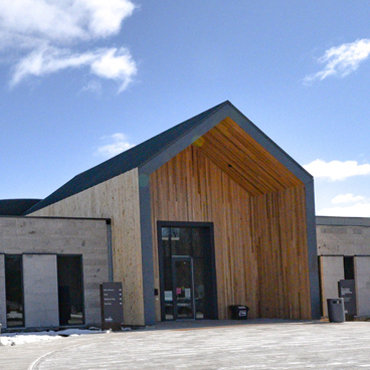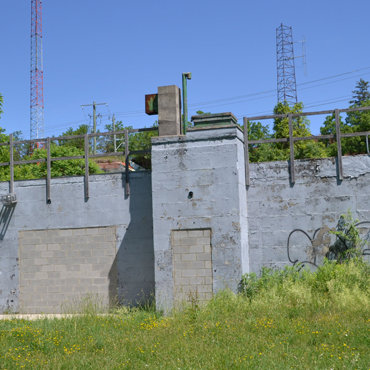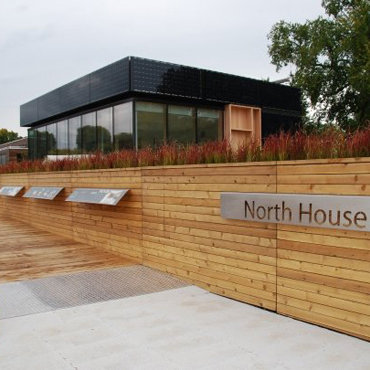The annual Doors Open event of Waterloo Region will be once again showcasing local places and buildings, making them available for all to see and to learn some of their stories. This year’s Doors Open program is entirely digital. A total of nine episodes will debut September 4 (two episodes), September 11 (two episodes) and September 18 (five episodes). All episodes will premiere on the Region Of Waterloo’s YouTube channel and will be featured on Rogers TV.

Gies Family Centre – Hospice Waterloo Region in Waterloo.
Architect: Neo Architecture Inc. Contractor: Melloul Blamey. Image from melloul.com
If any of the buildings or places at Doors Open piqued your interest, take the time at a later date to check them out in person. I have inserted mages of some of the buildings featured this year, and I promise you that there is much more to them than what you see here! As architects, we feel that judging architecture by looking at pictures is most inadequate. You have to physically be there to experience it!
So now that your attention is in these buildings, do you know what to make of them, or even, know where to place your attention?
If you want to know more about understanding architecture and how to judge it, I recommend reading How Architecture Works – A Humanists' Toolkit by Witold Rybczynski, a Canadian architect, professor, and writer. With his warm and approachable style, the author writes about the different aspects that architects have to consider when plying their trade and how these are employed to support an architectural idea.

Cold War Bunker – Kitchener
Architect: Webb Zerafa Menkes and Matthews. Image from engagewr.ca
Inspired by this book, I have asked architects at our firm two questions: 1) how do they go about judging a building, and 2) do they distinguish architecture from “merely a building”?
“When I am evaluating buildings,” says Matt, “I prefer to focus not on aesthetics (since these are subjective, and there is room for many different opinions on what looks good or not), but rather on whether or not the built solution contributes to, or takes away from the public realm (i.e the streetscape). Does it offer views in to or from the building so that I can see life and activity inside, so that I see that I am not alone, contributing to my sense of safety, especially during the night environment? Or, does the building create a wind sail or wind tunnel or a shadow that leaves the sidewalk constantly in the shade or exposed to gale force winds?
A pet peeve of mine is that often designers seem to insist that our building be multiple shades of grey. We live in a northern climate, that is dark and with grey weather for a larger portion of the year. So, I always judge a building on whether it offers a sense of warmth or colour, or something that helps make 4:40PM in January seem more tolerable.”
Mila recommends to always ask why. “While we may not be able to exactly figure out the reason behind each and every design decision, asking why may lead to some clues, and can help us evaluate the success of a building or not.
For instance, when considering whether a building blends into or stands out from its surroundings, asking why may lead to clues about whether the building may have been designed a certain way to respect its heritage context or it may be a performance hall or other public building that was deliberately designed to stand out.”
I use a four step process for trying to understand a building’s intent:
1. Go there, physically and use all your senses – look, listen, feel, smell, touch.
2. Use your heart: Try to describe what you like and what you don't as you walk around. Like people, every building, place and space have some great qualities, and others not so great. Applying adjectives you use to describe people, such as friendly, warm, generous, calm, humble, etc, (or their opposites) works well.
3. Use your brain: Make a clinical description of the building's context, massing, orientation, its approach, façade, entrance, and any other features that might be relevant. This step helps uncover some of the issues the designer had to grapple with.
4. Put together your thoughts of #2 & #3. Do they support each other? Do you see a pattern? Hopefully, now you have a feeling for how the building contributes to the realm. There are no right answers, and they might change with time.
For John, the diagram of movement, from public to semi-public to semi-private to private has to have grace, and a rich and coherent weave:
“Is one of the steps missing? What does it offer at each, to the observer and user moving past, moving through, and experiencing? How gracefully does it transition, welcome, appropriately invite across the divisions? But mostly, how does it communicate an idea while supporting and respecting other stories, other voices, and points of view?”
As for the second question, no one at JMA thought it necessary to distinguish between “Architecture” and “mere buildings”.
Mila goes further, in thinking that Buildings must be Architecture & Architecture must be Buildings. “The practice of architecture and society have done themselves a disservice by not seeing all buildings as architecture. The distinction has created a belief that architecture is an elitist luxury that is only accessible to the wealthy. This belief also harms the built environment as less care and effort are ascribed to just-buildings versus architecture. Perhaps, if we considered all buildings as architecture and architecture as all buildings, then more care would go into the built environment and creating long-lasting quality architecture for everyone in the present, near and distant future.”
I prefer to avoid the issue, and instead speak of the “built environment”. The synergy among a multitude of human interventions and all that nature offers are at the core of the feel of a place. Ideally, new interventions improve the feel of the place as they support everyone in their activities in a way that will raise their spirit.
Put your criticism tools to work and share your thoughts about buildings you saw at Doors Open. It will help us be better architects!

North House at rare Charitable Research Reserve in Cambridge
A competition entry for the 2009 International Solar Decathlon – U.S. Department of Energy .
Designed by Team Ontario - Architect of Record: RVTR, of Michigan, U.S.A.
The Team has strong representation from staff and students of the University of Waterloo School of Architecture– Image from raresites.org



